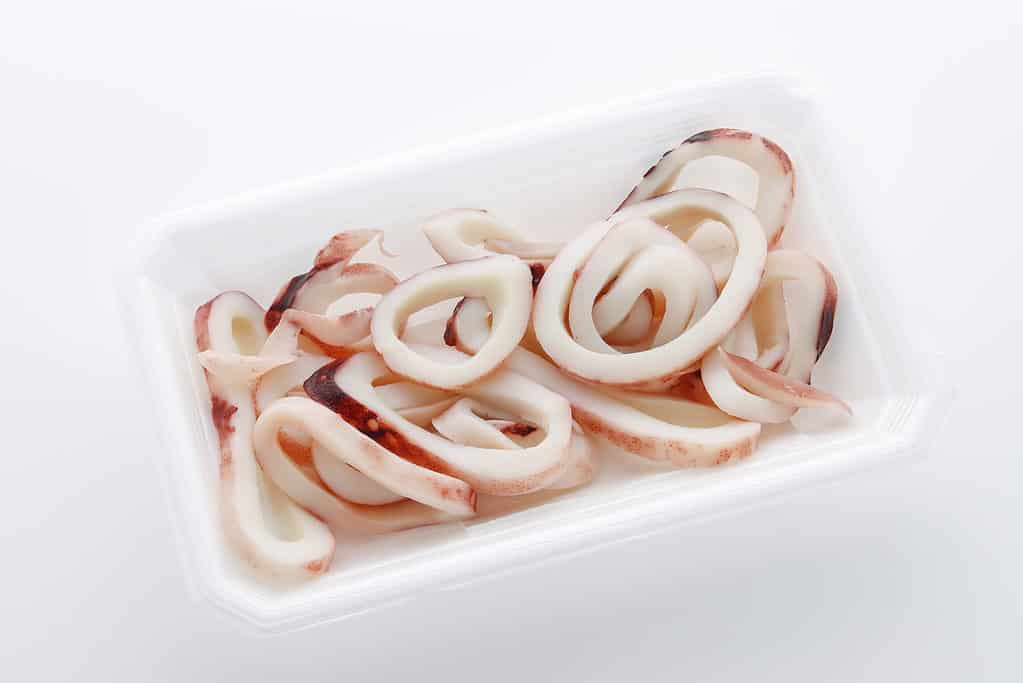Calamari is the name for cooked squid. You either love its unusual taste or can’t stand the thought of it near you! Either way, your dog will be looking for a bite, but can dogs eat calamari safely or is it toxic?
The answer isn’t quite as simple as a plain yes or no, so let’s find out more.
Is Calamari Safe for Dogs to Eat?
It depends. Calamari isn’t toxic when it’s well cooked, plain, and given in small amounts on occasion, but that leaves a large range of unsuitable calamari types.
The problems lie in the way we cook squid to make calamari because it includes high-fat oily coatings and various dressings that are bad news for Rover. There’s also an issue with high mercury levels and intestinal parasites.
We’ll look at all the problems with calamari in greater depth below, but the bottom line is yes your dog can eat small amounts of calamari if it’s plain and cooked thoroughly.

Your dog can eat small amounts of calamari if it’s plain and cooked thoroughly.
©Jaromir Chalabala/Shutterstock.com
What Is Calamari?
Calamari is cooked squid! Calamar is the Spanish word for squid and it’s where we get the name.
Calamari is usually cut into slices and because squids are round-bodied this results in squid rings. These rings are then steamed, baked, grilled, or most commonly in North America, battered or breadcrumbed and then fried. Calamari is a common dish in American seafood restaurants where it’s usually an appetizer, but in Asian countries it’s most often stuffed and grilled or added to noodle-based stir-fries.
But what is a squid you ask? Well, squid are amazing soft-bodied mollusks of the oceans. They have large eyes, eight arms, and a rigid internal gladius made of chitin. They are capable of changing color and some are even bioluminescent. When chased they eject ink to camouflage themselves and confuse predators like seals, dolphin, albatross, and whales.

Calamari is cooked squid.
©iStock.com/y-studio
Health Benefits of Calamari
When it’s not covered in dressing or fried in oil calamari is low fat and a really good source of protein. Protein is great for dogs because it help them build strong muscles, repair cells, and helps them grow strong fit bodies that recover quickly from exercise.
Plain calamari also has the following benefits:
- Phosphorus – repairs cells and muscles and balances other vitamins and minerals
- Calcium – contributes to strong bones, teeth, and claws plus it supports blood clotting
- Magnesium – boost muscles, nerves, and energy production
- Thiamine – turns food into energy and supports the nervous system
- Potassium – balances fluid inside cells
- Riboflavin – essential for red blood cell production, growth, and fighting free radicals
- Iron – creates healthy red blood cells to fight lethargy
- Copper – supports healthy immune systems, blood vessels, and nerves.
- Zinc – supports cell division, the immune systems, and formation of DNA
- Fatty acids – reduce inflammation and boost joints and brain function. They can also help reduce cholesterol and resulting heart disease.
It’s Low Calorie
Calamari without the help of a deep fat fryer is a healthy nutrient-filled seafood, but it’s also incredibly low in calories. 56% of dogs in the United States are overweight or obese according to the Association for Pet Obesity Prevention and that makes them more prone to diabetes, cancer, and joint problems.
And It’s Very Low In Fat
High fat foods are a problem for dogs not only because they pack on the pounds, but because they’re a prime trigger for pancreatitis.
This painful reaction occurs when the pancreas becomes inflamed and releases food-digesting enzymes when no food is present. These enzymes attack the pancreas and start to digest it. It’s very painful and distressing for dogs, not to mention expensive for the owner who will need to pay for pain relief, anti-vomiting meds, and potentially antibiotics too.
The good news is plain, unseasoned and unfried calamari is very low in fat.

Plain, unseasoned and unfried calamari is very low in fat.
©iStock.com/bee32
The Risks of Calamari
There are lots of nutrients in calamari, but there are some risks too. Let’s take a look.
Deep Fat Frying
Calamari that’s been breaded or battered and then fried is not safe for dogs to eat. It’s not toxic unless they have a wheat or gluten allergy, but it’s so high in oil and fat it can trigger pancreatitis and pile weight on your pooch very quickly. Dogs are smaller than us, so they need less food. It’s very easy to overfeed them.
High-fat foods can also cause gastrointestinal upsets such as flatulence, diarrhea, retching, and vomiting, all distressing for your dog and unpleasant for you.
Toxic Dressings
Dressings like mayo and dips are common accompaniments to calamari (is this making you hungry!) but dressings are bad news for dogs in a number of ways.
Sugar is calorific and damages their teeth, but low sugar versions can be even worse because they often contain xylitol, an artifical sweetener that’s highly toxic. Xylitol creates a big drop in blood sugar that can make your dog hypoglycemic. There are cases of dogs dying from xylitol poisoning, so it’s not something to risk.
Many dressings also contain garlic and onion too, which are toxic and have the potential to make dogs anemic.
High Mercury Levels
Some types of seafood can contain high levels of mercury that poisons the liver and kidneys. Calamari doesn’t have a lot of mercury, but it can build up over time. That’s why regular portions of squid isn’t recommended for dogs. Long lived fish like tuna and swordfish can also contain high mercury levels.
The symptoms of mercury toxicity are stomach pains, high blood pressure, and irrationality.
Seafood Allergy In Dogs
Just like humans, some dogs are allergic to seafood. It’s not common, but it can happen. If it’s your first time giving calamari to your pooch, give them a small amount and monitor their reaction over few days.
Seafood allergy symptoms in dogs include a swollen face, incessant scratching, hives, sneezing, and red skin. A less severe reaction is a seafood intolerance that manifests itself in stomach aches, diarrhoea, vomiting, poor coat quality, and general lethargy.
Both need a vet’s attention, but allergies are an emergency, so move fast.
Internal Parasites
Uncooked squid may contain a parasite called Anisakiasis (herring worm disease). When dogs (or humans!) eat raw or under cooked squid, parasitic worms may attach themselves to the intestines, stomach and oesophagus.
Anisakiasis causes stomach ache, vomiting, loose stools, a swollen stomach, bloody stools, and even mild fever. Vet treatment is required if you suspect your dog has parasites from raw squid. The Center for Disease Control (CDC) recommends never eating raw squid due to this parasite.

Risks to dogs associated with calamari include seafood allergies, build up of mercury levels over time, parasites, high fat and toxic dressings.
©iStock.com/shironosov
My Dog Ate Calamari, What Should I Do?
If they ate a small amount of cooked plain calamari, chances are they’ll be just fine. Monitor them for a few days and if they develop an allergy or parasitic symptoms talk to a vet.
If they develop an allergic reaction, speak to a vet straight away. Vet attention is also required if they ate a lot of fried calamari and have an unpleasant reaction.
How To Cook Calamari For Dogs
So, we know it’s not a good idea to feed dogs raw calamari, even if the most nutrients are available that way.
The best way to prepare seafood for your dog is boiling, steaming or grilling because this destroys any parasites and bacteria without adding toxins or fat. The aim is to give your pooch cooked, plain calamari with nothing added, not even a pinch of salt! It might look boring to you, but it’s the only safe way.
Before letting your dog tuck in, let it cool down and chop it into small pieces to avoid choking.
The ASPCA recommend dogs have a maximum of 10% treat foods in their daily diet, so go easy on calamari and make sure your pooch gets at least 90% of their meal from a good quality complete dog food.

The best way to prepare seafood for your dog is boiling, steaming or grilling to destroy any parasites and bacteria without adding toxins or fat.
©iStock.com/tycoon751
Is Calamari OK for Dogs?
Calamari (or cooked squid) is only safe for dogs if it’s plain and well cooked Fried calamari with dressings isn’t safe due to potential toxins like garlic and xylitol, plus the risk of oil content provoking pancreatitis.
Raw calamari is also off the menu due to its potential for bacterial or parasitic infection.
Up Next
- Can Dogs Eat Oysters
- Can Dogs Eat Scallops, Or Are They Deadly?
- Can Dogs Eat Liver
- Can Dogs Eat Bologna?
The photo featured at the top of this post is © iStock.com/mj0007
Ready to discover the top 10 cutest dog breeds in the entire world?
How about the fastest dogs, the largest dogs and those that are -- quite frankly -- just the kindest dogs on the planet? Each day, AZ Animals sends out lists just like this to our thousands of email subscribers. And the best part? It's FREE. Join today by entering your email below.
Sources
- Timoti's / Accessed December 17, 2022
- ScienceDirect / Accessed December 17, 2022
- Healthline / Accessed December 17, 2022
Thank you for reading! Have some feedback for us? Contact the AZ Animals editorial team.







